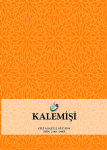SAÇAKLAMA TEKNİĞİ VE PAZEN KUMAŞA UYGULANMASI
VALANCE TECHNIQUE AND AN APPLICATION TO FUSTIAN
Author(s): Sema ÖzhanSubject(s): Customs / Folklore, Visual Arts, 16th Century
Published by: Sanat ve Dil Araştırmaları Enstitüsü
Keywords: fustian; valanced; textile;
Summary/Abstract: It was started in the 1500s, to decorate the cloths with contrast colored silk with horizontal and vertical cuts and to became fashion over time. In the early 1500s, soldiers of the Swiss army put colorful silk fabrics that they plundered from the enemy camp into their torn uniforms, thus protecting their bodies from the cold. This movement, which the soldiers returning to their country with improvisation on their uniforms, has been adopted by the public and transformed into a fashion flow that has been imitated and influenced Europe in a short time. This technique called as “valanced” in the literature and has been translated into Turkish as a “saçaklama tekniği”. The use of term “saçaklama tekniği” has been preferred, since the technique which is mentioned in the article is not included in the fashion terms. It has been used to cut of fabric surface by Textile Artists as a decorative technique in textile art and quilting applications. For example, artist Tim Harding creates a pixel-like effect by creating simultaneous contrast in his works by layering colored silk fabrics with an impressionistic approach. In this study, we aimed to add “saçaklama tekniği” into literature and to draw attention to diminishing use of fustian by sewing 3 vest of Anatolian colored and patterned fustian fabrics.
Journal: Kalemişi - Türk Sanatları Dergisi
- Issue Year: 6/2018
- Issue No: 12
- Page Range: 333-345
- Page Count: 13
- Language: Turkish

